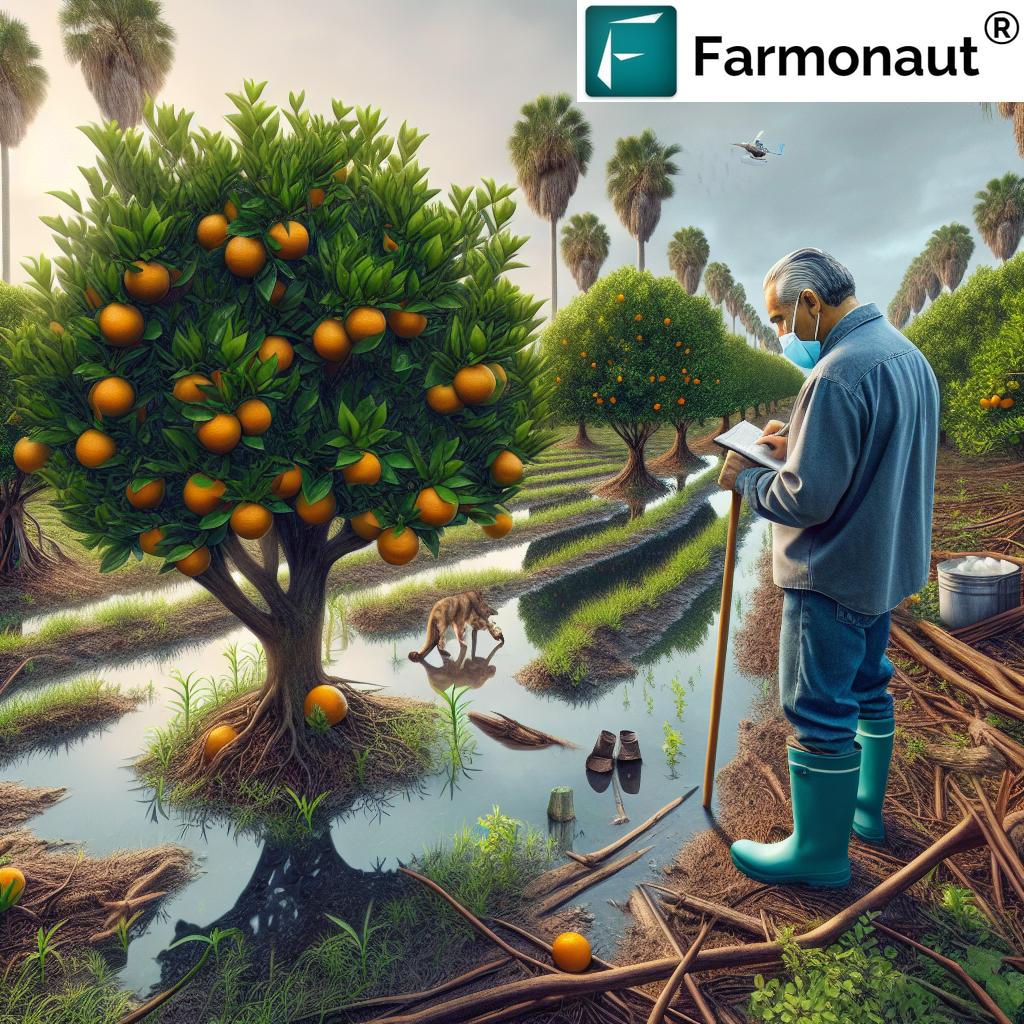Florida Orange Growers: Citrus Greening & Climate Impacts
“Florida’s orange production dropped over 70% since 2004 due to citrus greening and climate-related challenges.”
Introduction: The Changing Landscape of the Florida Citrus Industry
For decades, the Florida citrus industry stood as a defining symbol of the state’s economy, landscape, and cultural identity. Known globally for its vibrant oranges and abundant groves, Florida has contributed immensely to U.S. and worldwide orange juice production. However, over the last two decades, this vital industry has faced unprecedented challenges, marked by the twin threats of citrus greening disease (huanglongbing or HLB) and the mounting effects of climate change.
The decline in orange production—down by nearly 90% from its peak—has been attributed to a relentless bacterial disease and increasingly severe extreme weather events caused by climate change. The combined impact has reshaped Florida’s groves, affected thousands of growers, and sent shockwaves through the agricultural economy. This blog explores the causes, the extent, and the adaptation strategies paving the way for a more resilient and sustainable future for Florida citrus.
Overview of the Florida Citrus Industry
The Florida citrus industry has a storied history stretching back to the 1800s, shaping local economies, towns, and even the state’s identity. By the late 20th century, Florida produced over 244 million boxes of oranges annually. With more than 400,000 acres of commercial groves and thousands of growers, citrus was more than an agricultural sector—it was a way of life and a critical economic engine.
But, the industry’s downturn began to accelerate in the early 2000s with the arrival and rapid spread of huanglongbing (HLB), also known as citrus greening disease. Coupled with the intensifying impacts of climate change—including stronger hurricanes, unpredictable rainfall, and rising temperatures—this has led to record-low yields, grove losses, and economic distress.
- The Florida orange production decline is among the most severe in U.S. agricultural history.
- Production has fallen from 244 million boxes (1998) to an estimated 12 million boxes (2024–2025).
- Key causes: Citrus greening disease and climate change impacts on citrus.
Key Focus Areas of Decline
- Groves: Drastic reduction in healthy acreage, with many trees and entire groves lost to disease or storms.
- Growers: Many small and mid-sized family growers have exited, unable to absorb mounting losses.
- Economy: Steep drops in production ripple through processing plants, trucking, marketing, and local businesses.
The challenges, while daunting, have also triggered innovative adaptation strategies. From new disease-resistant citrus trees to the adoption of cutting-edge technology, the industry is evolving—out of necessity and for survival.
Citrus Greening Disease (HLB): The Stubborn Threat to Florida’s Citrus
Citrus greening disease, technically known as huanglongbing (HLB), stands as the single most devastating disease the Florida citrus industry has ever faced. First detected in Florida in 2005, HLB is a bacterial infection that is spread by the Asian citrus psyllid insect. The disease infects the vascular systems of citrus trees, disrupting nutrient uptake and causing:
- Reduced yields and harvests
- Poor fruit quality (smaller, misshapen, bitter-tasting fruits)
- Increased tree mortality and eventual grove losses
How Citrus Greening Disease Spread Across Florida Groves
- Transmission: The Asian citrus psyllid feeds on leaves, spreading the HLB bacteria quickly across groves.
- Rapid Infection: By 2024, nearly 100% of Florida’s commercial citrus acreage is reported as infected.
- Threat to Sustainability: HLB’s chronic, incurable nature has made it an existential threat to the industry’s long-term resilience.
The effects are cumulative and long-lasting. Trees can survive for years but produce less viable fruit each season, straining growers’ ability to remain profitable. The costs to manage HLB (insecticide sprays, tree nutrition programs, and more frequent replanting) have soared, while marketable yields continue to decrease.
Keyword insight: Huanglongbing in Florida is one of the world’s most studied examples of a single disease fundamentally altering an entire agricultural economy.
Citrus Greening Disease: Key Facts
- Bacterial infection caused by Candidatus Liberibacter asiaticus
- Affects: Orange, grapefruit, tangerine trees
- First detected: Florida, 2005
- Impacts: Drastic reduction in overall fruit yields and increased tree loss
- Spread: Quickly became endemic throughout commercial groves
Visual Symptoms
- Blotchy mottling of leaves
- Yellow shoots with stunted leaves
- Misshapen, bitter-tasting fruit that often drops prematurely
Growers and scientists agree: Without an effective cure for HLB, combating this bacterial disease remains the top priority for all adaptation strategies in the Florida citrus industry.
Discover more about advanced disease detection and nutrient mapping for plantations on our Large-Scale Farm Management platform, designed to equip agribusinesses and plantation managers with satellite-based insights on crop health, tree losses, and yield predictions.
Climate Change Impacts on Citrus: The Mounting Effects of Extreme Weather Events
As if HLB were not enough, Florida growers are grappling with a new, equally relentless force: climate change impacts on citrus. The past decade has seen a marked increase in the frequency and severity of extreme weather events—from hurricanes to prolonged droughts—that threaten both established groves and new plantings.
How Extreme Weather Has Intensified the Decline
- Hurricanes: Powerful storms like Hurricane Irma (2017) and Hurricane Ian (2022) caused widespread damage—uprooting trees, flooding fields, and damaging critical infrastructure.
- Economic Losses: Hurricane Ian alone resulted in losses between $416 million and $675 million (fb.org), further exacerbating industry challenges.
- Long-term Threat: Increasing frequency and severity of storms—directly linked to climate change—continue to undermine efforts at recovery.
Extreme Weather Effects on Agriculture
- Flooding: Prolonged saturated soils stunt root systems, leading to poor nutrient uptake and making trees highly susceptible to pests and disease.
- Wind Damage: Uproots trees, strips fruit, and snaps young branches essential for next year’s crop.
- Infrastructure Damage: Processing plants, irrigation pumps, and roadways are often destroyed or rendered inoperable during hurricanes.
- Heat Waves & Droughts: Higher average temperatures accelerate water loss, stress trees, and degrade fruit quality during development.
Given the climate change challenges facing Florida’s orange growers, the Farmonaut Carbon Footprinting tool empowers producers and agribusinesses to track, understand, and reduce their environmental impact. With real-time emissions monitoring, growers can adopt mitigation practices that lower their carbon footprint and strengthen eligibility for sustainability-focused grants and incentives.
Economic and Social Impact of Citrus Decline in Florida
The combined pressures of citrus greening disease and climate change impacts have not only battered production but also caused sweeping economic and social changes across Florida. Traditionally, the citrus industry supported more than 32,000 jobs and contributed nearly $6.9 billion annually to the state’s economy.
But as groves shrink and production drops, consequences have rippled throughout rural communities:
- Lost Jobs: With fewer oranges to harvest, thousands of seasonal and permanent industry jobs have disappeared.
- Rising Costs: Scarcity of Florida oranges has caused orange juice prices to soar, with futures nearly doubling in the last year alone (ft.com).
- Land Use Change: Former groves are being converted into residential developments as agricultural land becomes less valuable and more growers exit the market.
- Community Impact: Loss of citrus groves alters local culture, history, and town economies built around orange production.
Alico Inc. Case: A Sign of Transformation
One striking example is Alico Inc.—historically one of the largest citrus growers in Florida—which has announced a step away from groves to focus on residential development. This move showcases the economic impact of citrus decline and the broader trend as citrus cultivation gives way to urban expansion.
Adapting to economic volatility, the Farmonaut Crop Loan and Insurance Verification service uniquely empowers growers and financial institutions to validate farm locations, acreage, and conditions via satellite, improving access to financing and reducing fraudulent insurance claims.
Wider Economic and Cultural Effects
- Impacts reach well beyond farmers, affecting packers, processors, shipping, retail, and even Florida’s identity as the “Orange State.”
- The loss of citrus groves diminishes green space and disrupts ecological balances established over generations.
Adaptation Strategies for Citrus Growers
Despite the grim statistics, adaptation strategies for citrus growers are emerging as the cornerstone of industry resilience. The path to recovery for the Florida citrus industry involves a multi-pronged approach:
1. Enhanced Research and Policy Support
- The Florida Legislature allocated $47 million for 2024–25, with $18 million going specifically to research on combating citrus greening.
- Policy initiatives focus on supporting existing growers, incentivizing replanting, and developing disease-resistant citrus trees.
2. Innovative Disease Mitigation Tools
- Antibiotic Injections: Technologies like ReMedium TI introduce antibiotics that suppress HLB bacteria within affected trees, reducing fruit drop and extending productive life.
- Precision Agriculture Tools: Satellite and sensor-based health monitoring help growers detect early signs of stress and optimize resource application.
Looking for advanced solutions? Explore how Farmonaut’s blockchain-based traceability tools bring transparency and trust to the agricultural supply chain by mapping every stage from grove to glass.
3. Breeding and Genetic Research
- Genetically Modified Trees: Scientists are engineering rootstocks and trees incorporating genes from spinach or mustard plants to increase disease resistance.
- Long-term Timeline: Even with breakthroughs, new trees may take up to a decade to mature and produce fruit.
- The cost and wait-time pose risks for small growers facing immediate financial pressures.
4. Improved Field Management
- Targeted nutrition programs, advanced irrigation, and new weed/pest controls maximize yield from remaining healthy trees.
- Fleet and resource management—as enabled by Farmonaut Fleet Management—optimizes operational costs, tracks input applications, and protects investments in machinery.
- Switching to alternative crops: Some growers are trialing non-citrus crops or diversifying to improve risk resilience.
5. Tech-Enabled Monitoring and Decision Support
- Widespread adoption of digital farm management platforms—like those provided by Farmonaut—improves decision-making, tracks changes in grove health, and boosts overall sustainability.
- AI-based advisory systems: Predictive insights and real-time recommendations help growers anticipate outbreaks and react promptly to stressors.
Outlook on Adaptation and Mitigation
Integrating science, technology, and policy is the only viable way forward. The battle against citrus greening disease and the effects of climate change is ongoing, but adaptation strategies offer tangible hope of stabilizing—if not fully restoring—the Florida orange industry.
“Citrus greening disease now affects over 90% of Florida’s orange groves, threatening long-term industry sustainability.”
Comparative Impact Table: Disease & Climate on Florida Citrus (2012–2024)
The table below summarizes how citrus greening and climate change impacts have altered key aspects of Florida orange production over the past decade, capturing the relationship between disease prevalence, weather changes, and industry adaptation strategies.
| Year | Estimated Orange Production (millions of boxes) |
Estimated Number of Active Growers | Reported Cases of Citrus Greening (thousands of acres) |
Average Temperature (°F) | Notable Adaptation Strategies |
|---|---|---|---|---|---|
| 2012 | 146 | ~5,800 | ~350 | 72.0 | Nutritional sprays, targeted psyllid control, initial replanting efforts |
| 2017 | 54 | ~4,000 | ~475 | 72.8 | Post-Hurricane Irma recovery; exploring new rootstocks; AI-based health monitoring pilot programs |
| 2022 | 41 | ~2,800 | ~510 | 73.3 | Nutrient optimization, ReMedium TI antibiotic trials, fast-tracking genetic research, digital traceability adoption |
| 2024 (proj.) | 12 | <2,000 | ~540 | 73.7 | Legislative research support, expanded satellite monitoring, GM disease-resistant rootstock trials, carbon tracking tools |
These trends clearly demonstrate how citrus greening disease and climate change events have accelerated the decline in both production and grower participation, pushing the industry to innovate for survival.
Farmonaut Solutions for Citrus Growers: Driving Sustainability and Adaptation
At Farmonaut, we are committed to helping citrus producers and agribusinesses adapt to the rapidly changing reality of the Florida citrus landscape. Our advanced, satellite-powered platform equips both small and large growers with actionable insights for mitigating disease, monitoring environmental impact, and optimizing productivity during times of uncertainty.
Key solutions:
- Satellite-Based Crop Health Monitoring: Our system tracks crop vigor, detects early stress signals, and indexes tree health at the parcel level.
- AI-Driven Jeevn Advisory System: Personalized, real-time recommendations—from weather forecasts to targeted nutrition—that empower better, more informed decisions for each grove.
- Blockchain-Based Product Traceability: Build supply chain trust with transparent, tamper-proof blockchains documenting each harvest’s journey.
- Fleet & Resource Management: Monitor equipment, workers, and resource use—critical for cost control and efficiency during difficult seasons.
- Carbon Footprinting: Track carbon outputs in real time and implement targeted mitigation strategies to align with shifting regulations and consumer demand for sustainability.
Our vision is to make precision agriculture affordable and accessible—helping Florida orange growers weather all storms, disease or climate.
Try our platform via Web, Android, or iOS today for real-time crop insights.
Looking to plug satellite and weather data directly into your own tools? See details for our Satellite & Weather API and API documentation for developers.
FAQ: Florida Citrus Industry, Citrus Greening & Climate Impacts
What is citrus greening disease (HLB) and how does it affect Florida citrus?
Citrus greening, or huanglongbing (HLB), is a devastating bacterial disease spread by the Asian citrus psyllid. In Florida, it infects nearly all commercial citrus groves, disrupting trees’ vascular systems, stunting growth, causing fruit drop, and ultimately leading to massive production declines and higher tree mortality.
How has climate change impacted the Florida citrus industry?
Climate change has increased the frequency and severity of extreme weather events like hurricanes, floods, and heatwaves. These events damage citrus groves and infrastructure, reduce yields, and intensify losses already caused by citrus greening disease.
Why have orange juice prices risen so dramatically?
The sharp decline in Florida orange production—driven by disease and weather damage—has created shortages, causing orange juice futures to almost double in the past year as supply struggles to meet demand.
What are the main adaptation strategies for citrus growers?
Adaptation involves a combination of research funding, support for new disease-resistant trees, innovative management practices, satellite-based precision agriculture tools, and adoption of climate-smart technologies.
Are there solutions for supply chain transparency and sustainability?
Yes. Systems like Farmonaut’s blockchain-based traceability deliver full transparency, allowing growers and food companies to monitor every step of orange production and ensure environmental compliance.
Conclusion: Securing a Sustainable Future for Florida Citrus
The story of the Florida citrus industry is one of both loss and transformation. The rapid decline in production, economic impact, and shifting land use are clear evidence that the combined forces of citrus greening disease and climate change cannot be ignored. Yet Florida’s growers, researchers, and innovators continue to fight for the future.
Mitigating these challenges requires a holistic approach: robust research, swift adoption of new technologies, policy and financial support, and a cultural shift toward sustainability across the supply chain. As environmental and market pressures mount, there is still hope for a resilient and technologically advanced citrus sector.
At Farmonaut, our mission is to equip every grower with the tools they need to thrive in this demanding new landscape—enabling data-driven decisions, sustainable management, and transparent production for generations to come.
The Florida citrus industry’s future will be shaped by our collective ability to innovate, adapt, and remain vigilant against both disease and climate-related events. With the right adaptation strategies and ongoing support for research and sustainable practices, a brighter—if changed—future can emerge for Florida’s orange groves, growers, and communities.














